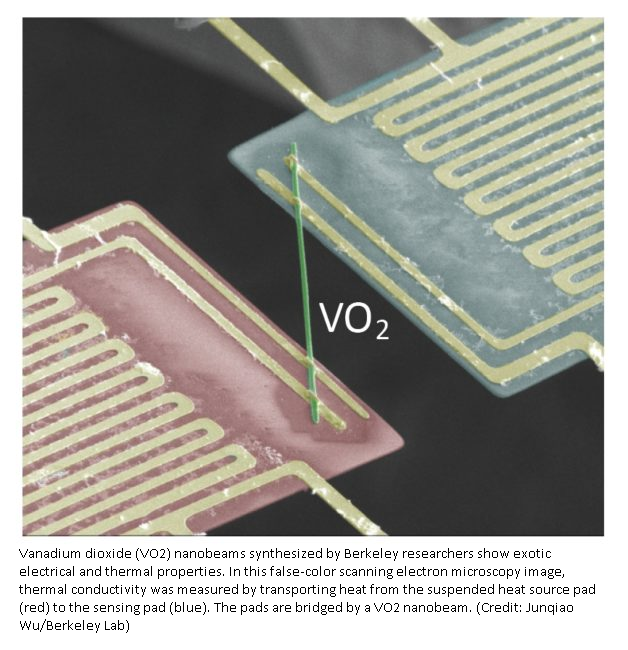Berkeley-led study finds law-breaking property in vanadium dioxide that could lead to applications in thermoelectrics, window coatings
There’s a known rule-breaker among materials, and a new discovery by an international team of scientists adds more evidence to back up the metal’s nonconformist reputation. According to a new study led by scientists at the Department of Energy’s Lawrence Berkeley National Laboratory (Berkeley Lab) and at the University of California, Berkeley, electrons in vanadium dioxide can conduct electricity without conducting heat.

Berkeley Lab scientists Junqiao Wu, Changhyun Ko, and Fan Yang (l-r) are working at the nano-Auger electron spectroscopy instrument at the Molecular Foundry, a DOE Office of Science User Facility. They used the instrument to determine the amount of tungsten in the tungsten-vanadium dioxide (WVO2) nanobeams. (Credit: Marilyn Chung/Berkeley Lab)
News Center
For This Metal, Electricity Flows, But Not the Heat
Berkeley-led study finds law-breaking property in vanadium dioxide that could lead to applications in thermoelectrics, window coatings
News Release Sarah Yang (510) 486-4575 • January 26, 2017
Share3.5K
Tweet26
Reddit
Share488
+148
Shares 4.0K
There’s a known rule-breaker among materials, and a new discovery by an international team of scientists adds more evidence to back up the metal’s nonconformist reputation. According to a new study led by scientists at the Department of Energy’s Lawrence Berkeley National Laboratory (Berkeley Lab) and at the University of California, Berkeley, electrons in vanadium dioxide can conduct electricity without conducting heat.
Berkeley Lab scientists Junqiao Wu, Fan Yang, and Changhyun Ko (l-r) are working at the nano-Auger electron spectroscopy instrument at the Molecular Foundry, a DOE Office of Science User Facility. They used the instrument to determine the amount of tungsten in the tungsten-vanadium dioxide (WVO2) nanobeams. (Credit: Marilyn Chung/Berkeley Lab)
Berkeley Lab scientists Junqiao Wu, Changhyun Ko, and Fan Yang (l-r) are working at the nano-Auger electron spectroscopy instrument at the Molecular Foundry, a DOE Office of Science User Facility. They used the instrument to determine the amount of tungsten in the tungsten-vanadium dioxide (WVO2) nanobeams. (Credit: Marilyn Chung/Berkeley Lab)
The findings, to be published in the Jan. 27 issue of the journal Science, could lead to a wide range of applications, such as thermoelectric systems that convert waste heat from engines and appliances into electricity.
For most metals, the relationship between electrical and thermal conductivity is governed by the Wiedemann-Franz Law. Simply put, the law states that good conductors of electricity are also good conductors of heat. That is not the case for metallic vanadium dioxide, a material already noted for its unusual ability to switch from an insulator to a metal when it reaches a balmy 67 degrees Celsius, or 152 degrees Fahrenheit.
“This was a totally unexpected finding,” said study principal investigator Junqiao Wu, a physicist at Berkeley Lab’s Materials Sciences Division and a UC Berkeley professor of materials science and engineering. “It shows a drastic breakdown of a textbook law that has been known to be robust for conventional conductors. This discovery is of fundamental importance for understanding the basic electronic behavior of novel conductors.”
In the course of studying vanadium dioxide’s properties, Wu and his research team partnered with Olivier Delaire at DOE’s Oak Ridge National Laboratory and an associate professor at Duke University. Using results from simulations and X-ray scattering experiments, the researchers were able to tease out the proportion of thermal conductivity attributable to the vibration of the material’s crystal lattice, called phonons, and to the movement of electrons.
Vanadium dioxide (VO2) nanobeams synthesized by Berkeley researchers show exotic electrical and thermal properties. In this false-color scanning electron microscopy image, thermal conductivity was measured by transporting heat from the suspended heat source pad (red) to the sensing pad (blue). The pads are bridged by a VO2 nanobeam. (Credit: Junqiao Wu/Berkeley Lab)
Vanadium dioxide (VO2) nanobeams synthesized by Berkeley researchers show exotic electrical and thermal properties. In this false-color scanning electron microscopy image, thermal conductivity was measured by transporting heat from the suspended heat source pad (red) to the sensing pad (blue). The pads are bridged by a VO2 nanobeam. (Credit: Junqiao Wu/Berkeley Lab)

To their surprise, they found that the thermal conductivity attributed to the electrons is ten times smaller than what would be expected from the Wiedemann-Franz Law.
“The electrons were moving in unison with each other, much like a fluid, instead of as individual particles like in normal metals,” said Wu. “For electrons, heat is a random motion. Normal metals transport heat efficiently because there are so many different possible microscopic configurations that the individual electrons can jump between. In contrast, the coordinated, marching-band-like motion of electrons in vanadium dioxide is detrimental to heat transfer as there are fewer configurations available for the electrons to hop randomly between.”
Notably, the amount of electricity and heat that vanadium dioxide can conduct is tunable by mixing it with other materials. When the researchers doped single crystal vanadium dioxide samples with the metal tungsten, they lowered the phase transition temperature at which vanadium dioxide becomes metallic. At the same time, the electrons in the metallic phase became better heat conductors. This enabled the researchers to control the amount of heat that vanadium dioxide can dissipate by switching its phase from insulator to metal and vice versa, at tunable temperatures.
Such materials can be used to help scavenge or dissipate the heat in engines, or be developed into a window coating that improves the efficient use of energy in buildings, the researchers said.
Hi! I am a robot. I just upvoted you! I found similar content that readers might be interested in:
http://newscenter.lbl.gov/2017/01/26/electricity-not-heat-flows-in-vanadium-dioxide/
Thanks